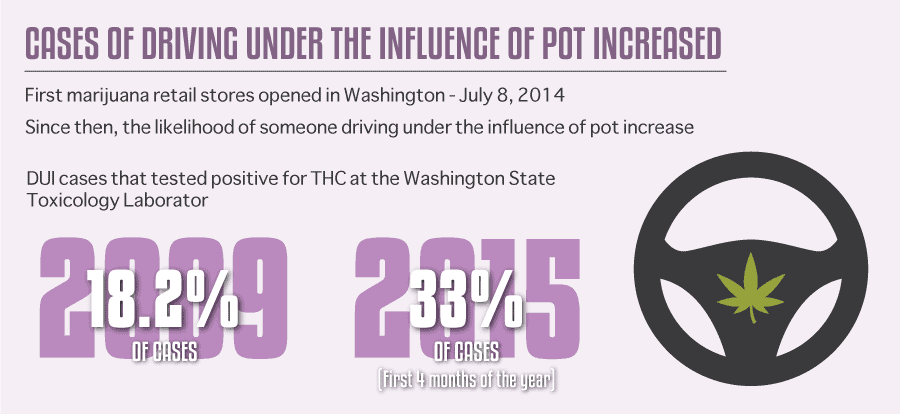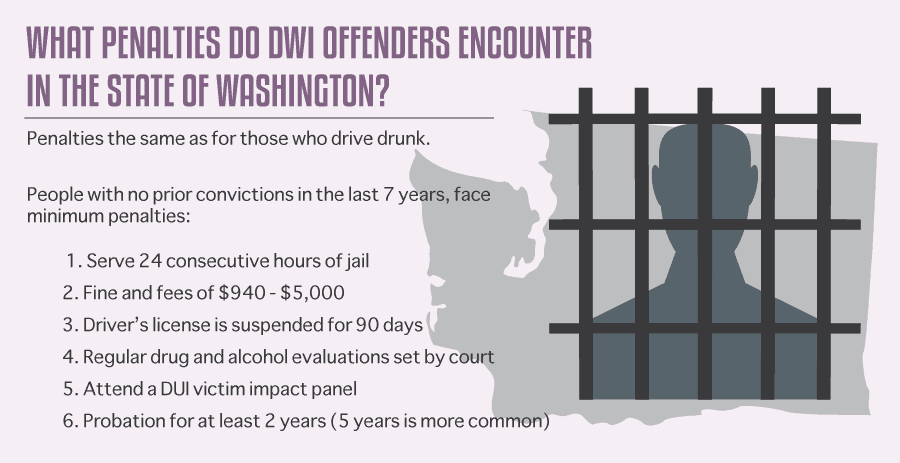Driving While Intoxicated (DWI) and Driving Under the Influence (DUI) are interchangeable terms in the eye of the law. When Washington State legalized recreational marijuana use in 2012 along with Colorado, it became one of two states in the U.S. to decriminalize adult possession, pass laws regulating marijuana sale, and enforce taxes on marijuana. The first retail stores in Washington opened July 8, 2014. In WA state, only those who are 21 and older are allowed to purchase and use weed for recreational use. Although there has been a dramatic decrease in arrests and convictions due to the drug, the likelihood of someone driving under the influence of pot has increased. In 2009, 18.2% of DUI cases received at the Washington State Toxicology Laboratory tested positive for THC. In the first four months of 2015, that percentage had increased to 33%. It’s possible that some of the rise in DUI convictions due to marijuana use is because law enforcement becoming better at identifying drivers under the influence.
“Is marijuana addictive? Our 28-Day Drug Rehab Program treats all types of substance use disorders.”
Although marijuana seems “natural” and “safe,” there are some side effects that can make driving hazardous: drowsiness, anxiety, hallucinations, poor judgment, etc. All can inhibit someone’s ability to drive. So why do some people think it’s safe to use while driving? With the stigma of pot use ebbing away in the wake of legalization and widespread use, it seems people believe it’s reasonable to use it more and in some cases misuse it more. 
What is the Definition of a DUI in Washington State and Does it Include Marijuana Use?
According to the Washington State Department of Licensing, “Driving under the influence (DUI) refers to operating a vehicle while affected by alcohol, drugs, or both. This applies to both legal and illegal drugs, including prescription medication and over-the-counter drugs. A driver is considered to be DUI when:
- “.08 or higher for adults (21 and over).
- .04 or higher for commercial vehicle drivers (CDL disqualifications).
- .02 or higher for minors (under 21).
or
- He or she is found to be driving a vehicle under the influence or affected by alcohol, any drug, or a combination of alcohol and drugs, regardless of the concentration of alcohol in their breath or blood.
- Starting August 1, 2012, the definition of a drug also includes any chemical inhaled or ingested for its intoxicating or hallucinatory effects.”
With the advent of legalized marijuana use, these definitions may change over time, but as the second portion of the law states, yes you can be arrested for being under the influence of pot and operating a motor vehicle. 
THC Blood Limits in DUI Offenders in WA State
In 2012, this “new approach” toward marijuana use was instated. This is the law that allows for the use and sale of pot. The legislation begins: “The people intend to stop treating adult marijuana use as a crime and try a new approach that: (1) Allows law enforcement resources to be focused on violent and property crimes; (2) Generates new state and local tax revenue for education, health care, research, and substance abuse prevention; (3) Takes marijuana out of the hands of illegal drug organizations and brings it under a tightly regulated, state-licensed system similar to that for controlling hard alcohol. This measure authorizes the state liquor control board to regulate and tax marijuana for persons twenty-one years of age and older, and add a new threshold for driving under the influence of marijuana. This means if under age 21, there is no change in the criminal law, it remains.” For marijuana use in Washington and Colorado, the current limit is 5 nanograms of delta-9-THC per milliliter of blood. If a driver is found with a THC level at or over that limit, they can be arrested and charged without proof of impairment due to another substance.
The Rise in Marijuana Use Among Those Charged with DUIs in WA State
Although overall casualties due to motor vehicle accidents has not increased, THC in the blood of drivers has. In August of 2016, the Washington Traffic Safety Commission released the following in a press release: “Newly released data from the Washington Traffic Safety Commission (WTSC) shows that marijuana is increasing as a factor in deadly crashes. The number of drivers involved in deadly crashes who tested positive for marijuana increased 48 percent from 2013 to 2014. “We have seen marijuana involvement in fatal crashes remain steady over the years, and then it just spiked in 2014,” said Dr. Staci Hoff, WTSC Data and Research Director. From 2010-2014, nearly 60% of drivers involved in fatal collisions were tested for drugs. Among these tested drivers, approximately 20% (349 drivers) were positive for marijuana.””
Why WA State Officials Have a Hard Time Charging People with DUI for Marijuana Use
The more long-term marijuana users are studied, the more we learn that THC levels may remain high in their body even if they are not currently under the influence. Some experts believe that you can’t really tell if someone is impaired by their THC blood levels alone. Again, although overall traffic-related fatalities have not grown, the THC content in drivers’ blood has. According to CNN, “But coming up with a test to get impaired drivers off the road will be far more difficult than the blood alcohol tests used to test for drunk drivers, according to the group. While tests show the ability to drive gets worse as blood alcohol rises, laboratory studies show the same is not necessarily true with increased levels of THC, the main chemical component in marijuana, in the blood. One driver with high levels of THC might not be impaired, while another driver with very low levels can be impaired.” Proof of driving while under the influence of marijuana abuse may elude law enforcement currently, but that will change as technologies for measurement become more accurate.
What Penalties do DWI Offenders Encounter in the State of Washington?
Besides the obvious risk to bodily injury to yourself and others, there are real penalties that will be imposed on DUI offenders for the use of marijuana. They are the same penalties for those who drive drunk. For a person with no prior convictions in the previous seven years, these are the minimum penalties:
- You must serve 24 consecutive hours of jail.
- Impose a fine and fees of $940.00 to $5,000.00.
- Your driver’s license is suspended for 90 days. When that period of time is over, it will only be reinstated if you install an Ignition Interlock Device and maintain it for one year, and have at least the last four months of the twelve month period with no failed tests.
- Regular drug and alcohol evaluations, and you must comply with all treatment recommendations set by the court.
- Attend a DUI victim impact panel.
- Placement on probation for at least two years (but five years is more common)
Often for first time offenders, these minimums are the harshest penalties anyone will serve. Usually, no additional jail time is ordered. However, aggravating factors can mean harsher penalties including prior criminal convictions, whether an accident occurred, if the incident endangered children, and whether there was a risk to members of the community. If there is a passenger under the age of 16 in the car, the court will order a $1000.00 fine for the first offense. Some counties and cities have jail alternatives to the 24 hour mandatory “imprisonment” period. These jurisdictions may allow you to complete training or other penalties within that time allotment. This gives some people alternatives to confining detainment.
Options for DWI/DUI Offenders After They Have Been Convicted
Life isn’t over after a DUI, but it can slow down progress in your career and home life. If you work a job that requires you to drive, you may be terminated. There is nothing to protect your job in the event you are arrested and convicted of DUI in Waashington state. Here are a few things you can do after you have been convicted of a DWI:
- In the meantime, getting into a good rehabilitation center can help you get back on your feet. Clearly, substance abuse is an issue for you if a DUI was a consequence of your drug misuse.
- Another thing you can do is educate others. Awareness is the key to setting expectations for drug use while operating a motor vehicle. It has the potential to save lives, and your story can serve as a warning to those who don’t take marijuana use and DWI seriously.
- Join a support group like Narcanon to get help from others who have been through the same things as you. They can give you opportunities to socialize without participating in substance abuse. They can also help you find a new job if you lost yours due to your DWI.
- Lastly, sobriety. Sobriety is the best course of action for someone who has a DUI. A long-term sober plan will help you get your life back on track and keep you safe. The benefits of sober living are immediate and long lasting if maintained.
How to Get Your License Reinstated After Getting a DWI in WA State
If you are charged with a DUI is Washington State, in order to receive your license again, you must fulfill the stipulations of your conviction and then, according to the Washington Department of Motor Vehicles: “While your reinstatement requirements will vary depending on the severity and circumstances of your DUI, you’ll generally need to:
- Complete an alcohol and drug treatment and education program.
- Make an application at the WA DOL.
- Pay a reinstatement fee of $150 (additional fees may apply).
- Pass any necessary driver’s license tests.”
The repercussions of losing your ability to drive can not be understated. It can remove your ability to work and get jobs in the future. If you are a parent, you will have limited mobility to take your kids to school and doctor’s appointments. Those consequences plus the fees alone should be enough to deter you from driving under the influence of marijuana or any other substance. If you have had a DUI or you are worried that your marijuana use has gotten out of control, contact a drug and alcohol detox program to help you get your life back on track. Pot is not a harmless drug as can be seen by those who drive under its influence. It is a drug like any other, and its use needs to be taken seriously.
What Did you Think About This Blog?
Give it a Rating!






